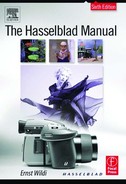20
Keeping Camera Equipment in Working Condition
Keeping your camera equipment clean is better than cleaning it. Keep all equipment away from dust and dirt whenever possible. Store each item in a case, with the covers on lenses and viewfinders, and front and rear covers on camera bodies if stored without a lens or magazine attached. Take great care when dusting the mirror, the viewing screen, or the bottom of the meter prism finder. Never touch the titanium focal plane shutter of the 2000/2003 cameras. Never use canned air for cleaning.
More detailed instructions for maintaining specific items in good working order are found in the chapters on lenses (Chapter 14), viewfinders (Chapter 11), and film magazines (Chapter 10).
MINIMIZING FUNGUS
In tropical climates, glass surfaces, lenses, prisms, and filters often become cloudy, a condition caused by fungi attacking the polished surfaces. Because the relative humidity decreases as the air temperature increases, you can reduce fungus development by keeping the camera equipment in the sun, in circulating air. Do not keep it in closed bags, drawers, or boxes. Grease and dust can also help fungi to develop and should be removed from the equipment.
Humidity in small areas can be reduced with desiccants. Silica gel, usually in the form of small crystals in a dustproof bag, is best for this purpose. Place the bag inside camera cases or airtight containers. Choose indicator gel, which changes color from blue to pink when it reaches a saturation point and needs regeneration. To regenerate it, heat it at 120–150°C (250–300°F) for about 12 hours.
Optical surfaces covered with a slight film of fungus should not be cleaned with alcohol but rather with a special fungus cleaner, if available. If fungus remains visible on the glass, return the equipment to the Hasselblad agent. Lens elements may have to be replaced.
When you are working in areas with high humidity, take the cameras and all the lenses out of air conditioned areas, including an air conditioned car, at least 30 minutes before you plan to photograph. All the glass surfaces on the lenses, the viewfinder, and the mirror in the camera will fog up when the camera comes out of the air conditioned area, and it may very well take 20 minutes before the fog disappears. Trying to remove the fog with cleaning tissue does not help. It comes right back until the surfaces have adjusted to the outside temperature.
COLD WEATHER PHOTOGRAPHY
The viscosity of lubricants increases (i.e., lubricants thicken) as the temperature declines, and consequently, in very cold weather, the camera mechanism may operate more sluggishly. Lens shutters may be affected, with shutter speeds becoming longer, especially if the lubricant in the lens and shutter is old. Hasselblad cameras and lenses are lubricated to work at very low temperatures, and special “winterizing” is no longer necessary or recommended. Reliable cold weather operation, however, can be expected only if the lubricants are fairly new. Have the lenses cleaned and relubricated before you work in very cold climates. Before you photograph, operate all the shutter speeds a few times with the magazine removed. This may get the lubricant working.
For cold weather photography, simplify camera operation as much as possible. Remove unnecessary accessories that cannot be operated with gloves, and add others that may help the operation. Reduce equipment changes as much as possible. Preload film magazines before you go into the cold, if possible.
When you are out in the cold, avoid touching the unpainted metal surfaces of your equipment with ungloved hands, your face, or your lips. The skin will stick to the metal. Some photographers cover the metal parts with tape to prevent this possibility. Don't breathe on the lenses. The condensation will freeze, perhaps instantly, and is then very difficult to remove. Condensation also occurs when cold equipment is brought into a warm room. This means that a chilled camera cannot be used until its temperature equals that of its surroundings. A camera with condensation also should not be taken out into the cold until the condensation has evaporated. If you do, the condensation will freeze. This can be serious, because condensation may also cover the camera and lens mechanism inside and may freeze up the camera and lens operation.
You can avoid condensation by placing the camera in an airtight plastic bag, squeezing out the air beforehand. In this way, the camera is not exposed to the warmer temperature. Condensation forms on the outside of the bag instead of on the lens and camera body.
TAKING CARE OF BATTERIES
All batteries have a tendency to drain quickly in low temperatures. Always carry a spare set, and keep them warm until they have to be used. Lithium batteries are better in cold temperatures than alkaline or silver oxide types.
Try to keep the camera in a warm place as long as possible, or remove the battery or batteries (the battery grip from the H camera) until needed. Don't forget the battery in the meter prism viewfinder.
